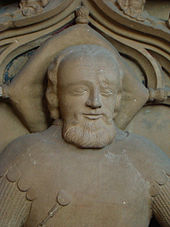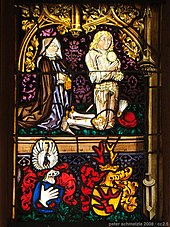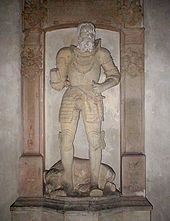Hirschhorn (noble family)
The Lords of Hirschhorn were a knightly family with ancestral seat Hirschhorn , who owned numerous estates in the valley of the lower Neckar , in the Little Odenwald , in the Kraichgau and on the Rhine . The extensive possessions were mainly due to acquisitions by Engelhard I and his grandson Hans V. von Hirschhorn in the 14th and early 15th centuries. The male family died out in 1632. The family coat of arms shows an upright stag pole with five ends.
history


Descent and first mention
The Lords of Hirschhorn are first mentioned in 1270 with Johann von Hirschhorn. They had their ancestral seat in Hirschhorn , where they built Hirschhorn Castle around 1220 on a fief of the Lorsch Monastery . The origin of the family is largely unknown, but there are indications that the Hirschhorns may have descended from the Lords of Harfenberg from Heddesbach , a branch of the noble free von Steinach , or were related to them early on.
Expansion of the rule under Engelhard I around 1350
Albrecht von Hirschhorn, the son of Johann mentioned in 1270, received in 1314 from Rudolf I the Harfenburg in Heddesbach, which had been given to the Palatinate County by the impoverished Harfenbergers . Albrecht's son Engelhard I. von Hirschhorn (proven 1336-1361) was the financier of several gentlemen and received extensive pledges from them. From Count Palatine Ruprecht I he received Sinsheim , Mosbach , Weißenburg , Meckesheim , Ober-Schönmattenwag , and in 1353 also Neckarau and Rheinhausen Castle with the associated village of Mannheim . From Mainz he received Starkenburg , Heddesheim and Bensheim in 1356 . In 1360, Emperor Karl IV pledged to him the Stüber Zent , an area encompassing roughly the entire Small Odenwald with all its places. By taking over the so-called Lindenberg fiefdom from Conrad IV. Von Erbach, which included the Lindenberg fortress and various possessions and rights in the villages of Gönheim , Alsheim , Gronau, Walsheim , Maudach , Flomersheim , Heßheim , Königsbach , Ruppertsberg , Ellerstadt and Haselbach, Eberhard I also managed to gain a foothold on the left bank of the Rhine. In 1355 he also acquired the entire rule of Bebenburg with 24 villages and in 1350 the temple in Neckarelz from the Order of St. John . The extensive expansion of Hirschhorn Castle, the castle chapel and the renovation of the Ersheim chapel , in which he was also buried in 1361, can also be traced back to Engelhard I. According to a document dated October 8, 1358, Engelhard von Hirschhorn and his wife Elisabeth had given the newly founded Liebfrauenstift Neustadt the parish of Ellerstadt, which is why every year, on the day after St. Francis, a glorious mass was to be sung at the sacrament altar there . this should happen on the days of her death after her death.
Engelhard II under imperial ban 1364-1383
Engelhard's son of the same name initially continued his expansionist efforts after the death of his father, but was then involved in protracted feuds. a. with his brother-in-law Burkhard Sturmfeder, supported by the Count Palatine, as well as with the bishopric of Mainz, which has been the feudal lord of Hirschhorn Castle since 1364 . The feuds with the Mainz Archbishopric also revolved around a relic, the finger of St. George , which Engelhard II is said to have stolen and not given back. Due to his various feuds, Engelhard II finally fell under imperial ban in 1364 , was captured by Count Palatine Ruprecht and held in captivity for years by his father-in-law Conrad IV von Erbach. During the period of the Reichsacht, part of the Hirschhorn property was lost; B. 1378 the Stüber Zent to the Electoral Palatinate . The imperial ban was only lifted after almost 20 years by the Roman-German King Wenceslaus in 1383.
Bloom under Hans V. around 1400
The son of Eberhard II, Hans V. von Hirschhorn († 1426), succeeded in increasing the property, which had been reduced by the father's imperial ban, and in expanding it to a new maximum. Hans V. was a lawyer and court master of the Palatinate , as well as a councilor in several cities (including Mainz , Worms , Speyer , Strasbourg and Frankfurt ). After the election of Count Palatine Ruprecht III. to the German king in 1400 Hans V was the royal envoy for around ten years, after the king's death in 1410 he was among the executors of his will alongside the Speyer bishop Raban von Helmstatt . Hans V. received numerous pledges for borrowed funds. In 1403 he and his brother Eberhard were enfeoffed with the Zwingenburg , which had been razed in 1364 and partially rebuilt in the meantime , which was then completely rebuilt under the Hirschhorns. After 1403 the Hirschhorns acquired from the previous owners, the impoverished lords of Zwingenberg, practically their entire former rule of Zwingenberg , which consisted of goods scattered around the area. The Hirschhorn House Law , written in 1393 and confirmed in 1411, goes back to Hans V., which stipulated the ancestral seat, the castle and the Hirschhorn, which was elevated to town status in 1391, as indivisible family property and forbade pledging and assignments as Wittum for the rest of the property . Together with his wife Iland geb. Wild countess and Rhine Countess zu Dhaun († 1431), his brothers Eberhard († 1420) and Conrad I (Canon of Mainz and cantor in Speyer; † 1413) and his nephew Conrad († around 1409), he also founded the Carmelite Monastery of Hirschhorn in 1406 . However, the numerous acquisitions and foundations of Hans V also led to an economic crisis for the family from 1416 in the last ten years of his life.
Financial crisis in the 15th century
Under Hans VI, the son of Hans V., the financial crisis widened, also because Hans VI. after 1430 in a protracted feud with the Würzburg bishop Johann II. von Brunn because of money borrowed years before, in the course of which the bishop through Hans VI. was even captured temporarily. But even after this means of pressure, urgently needed repayments and interest payments from Würzburg did not materialize, so that the brothers Hans VI. and Philip pledged parts of the property in spite of the prohibitions in the house law. Debts and pledges continued under Philip's sons Caspar, Melchior and Otto, although the elector had even approved a special tax to reduce their debts in 1462 and 1474. The crisis does not seem to have been overcome until 1500, when new acquisitions were made again under Caspar's son Hans VIII von Hirschhorn. Hans VIII also received the Zwingenburg , which had meanwhile been ceded to the Mosbach Count Palatine Otto II, back as an inheritance.
Time of the reformation
The sons of Hans VIII were Philip II († 1522), Georg († 1543) and Engelhard III. († 1529). Philip II was buried in 1522 according to Catholic custom, while Engelhard III. at his death in 1529 had already converted to the Protestant faith. In 1525 the Hirschhorns forbade the monastery friars to wear the religious costume, in 1528 they appointed Protestant preachers who had to be paid by the monastery. Engelhards III. Son, Hans IX. von Hirschhorn († 1569), after the death of George in 1543, completely carried out the Reformation in his dominion, also by banning the Catholic mass in 1546 and ultimately abolishing the monastery in Hirschhorn. In addition, he issued a uniform legal system for his rule around 1558. Since he was the only male descendant and child mortality was high at the time, he guaranteed his daughter Marie, who was married to Bernhard II Göler von Ravensburg , the right of feudal succession in the event that the family died out in 1556, despite two young sons Male trunk too.
Hans' IX. Sons, Ludwig I and Philip III. However, they reached adulthood and had sons, so that the property initially remained in the family. Ludwig I rebuilt the medieval castle in Hirschhorn to its present form in the Renaissance style.
Extinction of the family

Ludwig I († 1583) and his brother Philipp III. († 1585) made the abolished monastery in Hirschhorn the widow's seat of their mother, both died at the age of 40 and left underage sons. Ludwig's son Ludwig II (1584–1618) was only born after the death of his father, Philip's son Friedrich III. (1580–1632) was only five years old when his father died. The life of the nephews, who were initially represented by guardians, was overshadowed by tragedy.
Friedrich III. wounded his cousin, the 17-year-old Johann V. von Handschuhsheim, the last offspring of his family, at a tournament in Heidelberg on December 14, 1600, so that he died in January 1601. Friedrich was married to Ursula von Sternenfels for the first time , but their children all died in childhood. Ludwig II had a son who died in childhood in 1607, while the father was only 34 years old. Already with the death of Ludwig II in 1618 disputes began about the family inheritance, which the widow Ludwig claimed for a surviving daughter, which Friedrich III. with reference to the domiciliary rights of 1393 refused.

After the outbreak of the Thirty Years War , Friedrich III. suffer further cuts. The Catholic forces forced that the monastery in Hirschhorn was reopened, the church of which was no longer available to the local Protestant community, for which Friedrich had a new church built, the Marktkirche in Hirschhorn, from 1628. In 1629 his first wife died. In his second marriage, Friedrich was married to Agnes von Helmstatt from 1630 , in the same year he wrote his will because of a serious illness and in view of the lack of a descendant, in which he favored his half-sister Maria von Sternenfels with all of the allodial possessions and inheritance, whereas everyone else Heirs were only provided with movable property. Due to the war, the couple lived temporarily under the protection of the city of Heilbronn . Their common, late-born and only son Anselm Casimir (* 1631 in Heilbronn) died as a baby in August 1632, six weeks later, on September 22, 1632 the father also died. The coffins of the knight and his son were only rediscovered in 1880 during renovation work in Heilbronn's Kilian's Church.
Numerous epitaphs and coats of arms of the family have been preserved in their traditional burial places, the Carmelite monastery church in Hirschhorn and the Ersheimer chapel .
Disintegration of rule
At the death of Friedrich III. its allodial and fiefdom holdings comprised over 100 villages. After his death, the feudal lords, including the Emperor, the Electoral Palatinate , the Archbishopric of Mainz , the Diocese of Speyer and the Diocese of Würzburg , took back their fiefdoms, which already resulted in disputes about the belonging of certain areas. The individual fiefs went to different masters. The imperial fiefdom of Rothenberg near Hirschhorn and Finkenbach went to the Counts of Cronberg , the Electoral Palatinate fiefdom in Siegelsbach went to Baron Franz Melchior von Wiser , the Lindenberg fiefdom was given partly to Johann Reinhard von Sötern by the diocese of Speyer and partly to the former Hirschhorn registrar Ferdinand Feldgeschrey as a reward for clarifying the fiefdom. A Speyr fief went to Wolfgang Hartmann von Dalberg . Hirschhorn himself came to Rudolf Raitz von Frentz, then to von der Recke, and from 1700 it was Mainz's official seat for a century, but the castle and town fell into decline.
A legal dispute between the Electoral Palatinate and Messrs. Göler von Ravensburg over the shares in the Zwingenburg to which they were entitled from the will of 1556 dragged on until 1746. The shares were finally awarded to the Göler in order to be bought back the next day by the Electoral Palatinate.
See also
- List of Frankish knight families
- Adolf Schmitthenner described the Hirschhorn family in his novel "The German Heart".
Sources / literature
- Robert Irschlinger: On the history of the gentlemen of Hirschhorn , Verlag Der Odenwald 1969.
- Eberhard Lohmann: The reign of Hirschhorn. Studies on the rulership of a knight family . Darmstadt, Marburg 1986.
- Thomas Steinmetz: The descent of the Lords of Hirschhorn and the origins of their castle and rule . In: Geschichtsblätter Kreis Bergstrasse, 30 (1997), pp. 40–55.
- Eberhard Lohmann (Ed.): The wisdoms and village regulations of the Hirschhorn rule . Darmstadt 2001.
- Hansulrich Schüppel (Ed.): The Gemeyn order of the gentlemen of Hirschhorn from the year 1558 in the village book of Rothenberg . Erbach 2002.
- Christina Kimmel: Hans V. von Hirschhorn in the service of the Electoral Palatinate. A knight from the Neckar Valley at the Heidelberger Hof in the 14th and 15th centuries . Regional culture publishing house, Ubstadt-Weiher 1999, ISBN 978-3-89735-124-0
- Anke Stößer: Lords between the Rhine and the Odenwald. In: Knights, Counts and Princes - secular dominions in the Hessian area approx. 900-1806. Marburg 2014, ISBN 978-3-942225-17-5 (= Handbook of Hessian History 3 = Publications of the Historical Commission for Hesse 63), pp. 152–170, especially pp. 168–170.
Web links
- Thomas Steinmetz: Hirschhorn, noble family . In: Historical Lexicon of Bavaria
Individual evidence
- ^ Franz Xaver Glasschröder : New documents on the Palatinate Church History in the Middle Ages , Publishing House of the Palatinate Society for the Advancement of Science, Speyer, 1930, page 22, document regist No. 41




